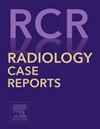通过血管内桥接支架置入术治疗恶性下腔静脉综合征(IVCS)
Q4 Medicine
引用次数: 0
摘要
一名73岁男性患者因呼吸困难及下肢严重水肿入院急诊科。患者在15个月前被诊断为广泛的小细胞肺癌。增强CT显示下腔静脉(IVC)在其进入右心房的水平受到肝上压迫,这是由占位性浸润性右肺病变引起的。下腔静脉综合征(IVCS)发生在通过下腔静脉的静脉流动阻塞后。躯干和下肢水肿是该综合征最常见的表现,而在更严重的病例中,心功能可能受到损害。考虑到患者的身体状况、疾病分期和症状的急性程度,下腔静脉血管内支架置入术优于手术或放疗。采用上腔静脉-下腔静脉搭桥支架入路,解决严重的肿块效应和下腔静脉狭窄与右心房交界处的位置。三个未覆盖的自膨胀支架从SVC串联部署到IVC。支架之间的重叠减少了右心房塌陷的风险,可能导致心脏传导障碍甚至心壁穿孔。在接下来的48小时内,患者经历了IVCS症状的缓解,但不幸的是,8天后因原发疾病去世。尽管在肿瘤病例中主要是姑息性的,svc - ivc支架植入术可以通过恢复心脏静脉回流,为晚期肿瘤患者提供快速和安全的症状缓解。本文章由计算机程序翻译,如有差异,请以英文原文为准。
Management of malignant inferior vena cava syndrome (IVCS) by endovascular bridging stent placement
A 73-year-old male patient was admitted to the emergency department with dyspnea and severe edema in the lower extremities. The patient had been diagnosed with extensive small-cell lung cancer 15 months previously. Contrast-enhanced CT revealed suprahepatic compression of the inferior vena cava (IVC) at the level of its entry into the right atrium, caused by a space-occupying, infiltrating right lung lesion. Inferior vena cava syndrome (IVCS) occurs after obstruction of venous flow through the IVC. Trunk and lower limb edema are the most common manifestations of this syndrome, whereas cardiac function may be compromised in more severe cases. Given the patient's performance status, disease stage, and symptom acuity, endovascular stenting of the IVC was preferred over surgery or radiotherapy. The superior vena cava (SVC)-to-IVC bridging stent approach was employed to address the severe mass effect and location of the IVC stenosis at its junction with the right atrium. Three uncovered self-expandable stents were deployed in tandem from the SVC to the IVC. Overlap between stents minimized the risk of collapse within the right atrium, possibly leading to cardiac conduction disorders or even perforation of the heart wall. The patient experienced alleviation of IVCS symptoms over the next 48 h but unfortunately passed away 8 days later from his primary disease. Although primarily palliative in oncologic cases, SVC-to-IVC stenting can offer rapid and safe relief of symptoms in patients with advanced oncologic disease by restoring venous return to the heart.
求助全文
通过发布文献求助,成功后即可免费获取论文全文。
去求助
来源期刊

Radiology Case Reports
Medicine-Radiology, Nuclear Medicine and Imaging
CiteScore
1.10
自引率
0.00%
发文量
1074
审稿时长
30 days
期刊介绍:
The content of this journal is exclusively case reports that feature diagnostic imaging. Categories in which case reports can be placed include the musculoskeletal system, spine, central nervous system, head and neck, cardiovascular, chest, gastrointestinal, genitourinary, multisystem, pediatric, emergency, women''s imaging, oncologic, normal variants, medical devices, foreign bodies, interventional radiology, nuclear medicine, molecular imaging, ultrasonography, imaging artifacts, forensic, anthropological, and medical-legal. Articles must be well-documented and include a review of the appropriate literature.
 求助内容:
求助内容: 应助结果提醒方式:
应助结果提醒方式:


